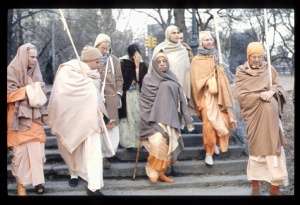CC Madhya 6.266 (1975): Difference between revisions
(Vanibot #0027: CCMirror - Mirror CC's 1996 edition to form a basis for 1975) |
(Vanibot #0020: VersionCompareLinker - added a link to the Version Compare feature) |
||
| Line 2: | Line 2: | ||
<div style="float:left">'''[[Sri Caitanya-caritamrta (1975)|Śrī Caitanya-caritāmṛta (1975)]] - [[CC Madhya (1975)|Madhya-līlā]] - [[CC Madhya 6 (1975)|Chapter 6: The Liberation of Sārvabhauma Bhaṭṭācārya]]'''</div> | <div style="float:left">'''[[Sri Caitanya-caritamrta (1975)|Śrī Caitanya-caritāmṛta (1975)]] - [[CC Madhya (1975)|Madhya-līlā]] - [[CC Madhya 6 (1975)|Chapter 6: The Liberation of Sārvabhauma Bhaṭṭācārya]]'''</div> | ||
<div style="float:right">[[File:Go-previous.png|link=CC Madhya 6.264-265 (1975)|Madhya-līlā 6.264-265]] '''[[CC Madhya 6.264-265 (1975)|Madhya-līlā 6.264-265]] - [[CC Madhya 6.267 (1975)|Madhya-līlā 6.267]]''' [[File:Go-next.png|link=CC Madhya 6.267 (1975)|Madhya-līlā 6.267]]</div> | <div style="float:right">[[File:Go-previous.png|link=CC Madhya 6.264-265 (1975)|Madhya-līlā 6.264-265]] '''[[CC Madhya 6.264-265 (1975)|Madhya-līlā 6.264-265]] - [[CC Madhya 6.267 (1975)|Madhya-līlā 6.267]]''' [[File:Go-next.png|link=CC Madhya 6.267 (1975)|Madhya-līlā 6.267]]</div> | ||
{{CompareVersions|CC|Madhya 6.266|CC 1975|CC 1996}} | |||
{{RandomImage}} | {{RandomImage}} | ||
==== TEXT 266 ==== | ==== TEXT 266 ==== | ||
| Line 25: | Line 24: | ||
<div class="translation"> | <div class="translation"> | ||
"There are five kinds of liberation: sālokya, sāmīpya, sārūpya, sārṣṭi and sāyujya. | |||
</div> | </div> | ||
| Line 32: | Line 31: | ||
<div class="purport"> | <div class="purport"> | ||
Sālokya means that after material liberation one is promoted to the planet where the Supreme Personality of Godhead resides | Sālokya means that after material liberation one is promoted to the planet where the Supreme Personality of Godhead resides. Sāmīpya means remaining an associate of the Supreme Personality of Godhead. Sārūpya means attaining a four-handed form exactly like that of the Lord. Sārṣṭi means attaining opulences like those of the Supreme Lord, and sāyujya means merging into the Brahman effulgence of the Lord. These are the five types of liberation. | ||
</div> | </div> | ||
Latest revision as of 18:56, 27 January 2020

A.C. Bhaktivedanta Swami Prabhupada
TEXT 266
- yadyapi se mukti haya pañca-parakāra
- sālokya-sāmīpya-sārūpya-sārṣṭi-sāyujya āra
SYNONYMS
yadyapi—although; se—that; mukti—liberation; haya—is; pañca-parakāra—of five different varieties; sālokya—of the name sālokya; sāmīpya—of the name sāmīpya; sārūpya—of the name sārūpya; sārṣṭi—of the name sārṣṭi; sāyujya—of the name sāyujya; āra—and.
TRANSLATION
"There are five kinds of liberation: sālokya, sāmīpya, sārūpya, sārṣṭi and sāyujya.
PURPORT
Sālokya means that after material liberation one is promoted to the planet where the Supreme Personality of Godhead resides. Sāmīpya means remaining an associate of the Supreme Personality of Godhead. Sārūpya means attaining a four-handed form exactly like that of the Lord. Sārṣṭi means attaining opulences like those of the Supreme Lord, and sāyujya means merging into the Brahman effulgence of the Lord. These are the five types of liberation.